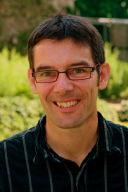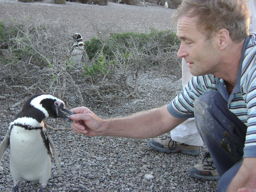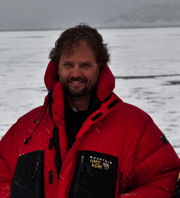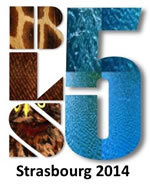A. ECOLOGY AND ENVIRONMENT
A1. Prof. Martin Wikelski (Max-Planck Institute for Ornithology / University of Konstanz, Germany)
 The Department of Migration and Immuno-ecology at Radolfzell Ornithological Station aims to understand why animals migrate, how they move from one place to another, and how they survive. To analyse global animal migrations, we equip individuals with state-of-the-art radio transmitters. Data from these transmitters are collected and stored in an online database accessible to researchers and the public across the globe. Between 2014 and 2020, the ICARUS-Initiative plans to establish a novel system capable of tracking even very small animals. This research will provide new insights into how organisms cope with the effects of climate change, disease, and man-made alterations to their environment.
The Department of Migration and Immuno-ecology at Radolfzell Ornithological Station aims to understand why animals migrate, how they move from one place to another, and how they survive. To analyse global animal migrations, we equip individuals with state-of-the-art radio transmitters. Data from these transmitters are collected and stored in an online database accessible to researchers and the public across the globe. Between 2014 and 2020, the ICARUS-Initiative plans to establish a novel system capable of tracking even very small animals. This research will provide new insights into how organisms cope with the effects of climate change, disease, and man-made alterations to their environment.
A2. Prof. Mark Hindell (University of Tasmania, Australia)
 Mark is Program leader of the Marine and Antarctic Ecosystems Program in the Institute for Marine and Antarctic Studies at the University of Tasmania. Prof Hindell has been working with Antarctic mammals and birds for more than 25 years, during which time has made 17 research trips to the Antarctic or sub-Antarctic. Drawing on a range of biological disciplines (including bio-telemetry, physiology, genetics and demography), his studies are united by the common theme of understanding how predator populations respond to environmental variability, and how this knowledge can then be used to investigate the implications of human activities (in the form of commercial fisheries or climate change) for Southern Ocean birds and mammals.
Mark is Program leader of the Marine and Antarctic Ecosystems Program in the Institute for Marine and Antarctic Studies at the University of Tasmania. Prof Hindell has been working with Antarctic mammals and birds for more than 25 years, during which time has made 17 research trips to the Antarctic or sub-Antarctic. Drawing on a range of biological disciplines (including bio-telemetry, physiology, genetics and demography), his studies are united by the common theme of understanding how predator populations respond to environmental variability, and how this knowledge can then be used to investigate the implications of human activities (in the form of commercial fisheries or climate change) for Southern Ocean birds and mammals.
B. BEHAVIOUR AND BEHAVIOURAL ECOLOGY
B1. Prof. John Fryxell (University of Guelph, Canada)
 The general questions being addressed by my research group are (1) how do ecological constraints shape animal behavior and (2) what are the consequent effects of behavioral decisions on population processes? Much of our work at the moment focuses on movement behavior. Working on animals ranging in size from freshwater rotifers to wildebeest, we are interested in developing robust models of individual movement based on complex random walks, then scaling up individually-based movement processes to consider patterns of population spread and rates of ecological interaction amongst species. Systems currently under study include large herbivores and carnivores in Serengeti National Park, woodland caribou, wolves, and moose in northern Ontario, and zooplankton and phytoplankton species in large mesocosms. One of our most exciting areas of research in recent years relates to the use of on-board video and accelerometer packages linked to GPS radio-collars to estimate fitness costs and benefits, as a means of developing robust models of state-dependent movement. The resulting movement models can then be used to evaluate the impact of habitat changes on long-term population viability.
The general questions being addressed by my research group are (1) how do ecological constraints shape animal behavior and (2) what are the consequent effects of behavioral decisions on population processes? Much of our work at the moment focuses on movement behavior. Working on animals ranging in size from freshwater rotifers to wildebeest, we are interested in developing robust models of individual movement based on complex random walks, then scaling up individually-based movement processes to consider patterns of population spread and rates of ecological interaction amongst species. Systems currently under study include large herbivores and carnivores in Serengeti National Park, woodland caribou, wolves, and moose in northern Ontario, and zooplankton and phytoplankton species in large mesocosms. One of our most exciting areas of research in recent years relates to the use of on-board video and accelerometer packages linked to GPS radio-collars to estimate fitness costs and benefits, as a means of developing robust models of state-dependent movement. The resulting movement models can then be used to evaluate the impact of habitat changes on long-term population viability.
B2. Prof. Rory P Wilson (Swansea University, UK)
 Rory works within the Swansea Laboratory for Animal Movement (SLAM), which comprises a group of people who study and attempt to understand animal movement in all its manifestations and for all its reasons. A major goal is the development of an energetic-based framework with which to examine any movement. Paramount in this is the acknowledgement that the capacity to describe animal movement is limited by technology. Thus, SLAM interacts with other departments within Swansea University, using the good-feeling, co-operative Welsh vibes, to develop animal-attached systems (such as the ‘daily diary’ – complete with accelerometers, magnetometers, speedometers and depth/height transducers) and research analytical techniques (such as ‘ODBA’, a proxy for movement-based energy expenditure - or ‘crystal ball’, a program that visualises multidimensional data) to enhance SLAM’s capacity to quantify movement and understand the reasons for it. The team works with animals as small as weevils and as large as whale sharks, incorporating such enigmatic creatures as beavers, condors, mouflon, penguins and sloths, happily collaborating with a suite of important and amicable people around the world in regions ranging from Antarctica to Norway.
Rory works within the Swansea Laboratory for Animal Movement (SLAM), which comprises a group of people who study and attempt to understand animal movement in all its manifestations and for all its reasons. A major goal is the development of an energetic-based framework with which to examine any movement. Paramount in this is the acknowledgement that the capacity to describe animal movement is limited by technology. Thus, SLAM interacts with other departments within Swansea University, using the good-feeling, co-operative Welsh vibes, to develop animal-attached systems (such as the ‘daily diary’ – complete with accelerometers, magnetometers, speedometers and depth/height transducers) and research analytical techniques (such as ‘ODBA’, a proxy for movement-based energy expenditure - or ‘crystal ball’, a program that visualises multidimensional data) to enhance SLAM’s capacity to quantify movement and understand the reasons for it. The team works with animals as small as weevils and as large as whale sharks, incorporating such enigmatic creatures as beavers, condors, mouflon, penguins and sloths, happily collaborating with a suite of important and amicable people around the world in regions ranging from Antarctica to Norway.
C. PHYSIOLOGY AND MEDICINE
C1. Prof. Dan Costa (University of California Santa Cruz, USA)
 Daniel Costa is a Distinguished Professor of Ecology and Evolutionary Biology at the University of California at Santa Cruz and holds the Ida Benson endowed Chair in Ocean Health. His research focuses on the ecology and physiology of marine mammals and seabirds and he has worked in almost every habitat from the Galapagos to the Antarctic. He has worked with a broad range of animals including penguins, albatross, seals, sea lions, whales and dolphins. He has been a pioneer in using animals to provide oceanographic data as well as data on their own behavior. His recent work has focused on understanding the relationship between climate-driven oceanographic processes and marine mammal and seabird foraging behavior and success. These studies are critical to provide an understanding of how climate change affects marine vertebrate populations. Specifically we know that marine vertebrates rely on physical oceanographic processes to concentrate or aggregate their prey. However, we do not understand the linkages between specific oceanographic features and the foraging behavior and success of individual marine vertebrates. Along with Barbara Block he founded the Tagging of Pacific Predators program. A multidisciplinary effort to study the movement patterns of 23 species of marine vertebrate predators in the North Pacific Ocean. He has served on a number of international science steering committees including the Integrated Climate and Ecosystem Dynamics program (ICED), The Census of Marine Life, CLIOTOP and the Southern Ocean Observing System (SOOS).
Daniel Costa is a Distinguished Professor of Ecology and Evolutionary Biology at the University of California at Santa Cruz and holds the Ida Benson endowed Chair in Ocean Health. His research focuses on the ecology and physiology of marine mammals and seabirds and he has worked in almost every habitat from the Galapagos to the Antarctic. He has worked with a broad range of animals including penguins, albatross, seals, sea lions, whales and dolphins. He has been a pioneer in using animals to provide oceanographic data as well as data on their own behavior. His recent work has focused on understanding the relationship between climate-driven oceanographic processes and marine mammal and seabird foraging behavior and success. These studies are critical to provide an understanding of how climate change affects marine vertebrate populations. Specifically we know that marine vertebrates rely on physical oceanographic processes to concentrate or aggregate their prey. However, we do not understand the linkages between specific oceanographic features and the foraging behavior and success of individual marine vertebrates. Along with Barbara Block he founded the Tagging of Pacific Predators program. A multidisciplinary effort to study the movement patterns of 23 species of marine vertebrate predators in the North Pacific Ocean. He has served on a number of international science steering committees including the Integrated Climate and Ecosystem Dynamics program (ICED), The Census of Marine Life, CLIOTOP and the Southern Ocean Observing System (SOOS).
C2. Prof. Chantal Simon (University of Lyon, France)
 Chantal is Professor of Nutrition and Senior Fellow in the Department of Diabetology of the University Hospital of Lyon. She is co-leader of a research team in the INSERM Laboratory CARMeN U1060 (CARdiovascular, Metabolism and Nutrition) and Member of CENS (Center for European Nutrition and Health). Her primary research interests are in the physiology of physical inactivity and sedentary behaviors; in their implication in the physiopathology of excessive weight gain and insulin resistance and in the contextual and socio-environmental determinants of health (particularly diet, physical activity and psychological wellbeing). A remarkable aspect of her research is to allocate great efforts in developing interventional studies using state of the art of bio-logging and stable isotopes techniques, and conducted in free living conditions to account for the major socio-ecological constraints that regulate human behaviors. Among other studies she conducted ICAPS, an interventional randomized study aiming at reducing sedentary behaviors in adolescents by acting on their environments and which is probably one of the most effective study in the field. ICAPS is now a reference brought forward at the national and international levels and its transferability in the general French population is currently evaluated. She is Member of the Scientific Advisory Boards of the French National Nutritional Health Plan and of the European Joint Program Initiative «A healthy diet for a healthy life”. She is author or co-author of more than 150 scientific international papers.
Chantal is Professor of Nutrition and Senior Fellow in the Department of Diabetology of the University Hospital of Lyon. She is co-leader of a research team in the INSERM Laboratory CARMeN U1060 (CARdiovascular, Metabolism and Nutrition) and Member of CENS (Center for European Nutrition and Health). Her primary research interests are in the physiology of physical inactivity and sedentary behaviors; in their implication in the physiopathology of excessive weight gain and insulin resistance and in the contextual and socio-environmental determinants of health (particularly diet, physical activity and psychological wellbeing). A remarkable aspect of her research is to allocate great efforts in developing interventional studies using state of the art of bio-logging and stable isotopes techniques, and conducted in free living conditions to account for the major socio-ecological constraints that regulate human behaviors. Among other studies she conducted ICAPS, an interventional randomized study aiming at reducing sedentary behaviors in adolescents by acting on their environments and which is probably one of the most effective study in the field. ICAPS is now a reference brought forward at the national and international levels and its transferability in the general French population is currently evaluated. She is Member of the Scientific Advisory Boards of the French National Nutritional Health Plan and of the European Joint Program Initiative «A healthy diet for a healthy life”. She is author or co-author of more than 150 scientific international papers.
D. AROUND BIO-LOGGING
D. Dr. Clive McMahon (Charles Darwin University, Australia)
 Bio-logging is a powerful and insightful field of study that allows us to study the cryptic lives and habitat structure of animals in detail with ever increasing precision, accuracy and duration. But, equipping animals with recording and tracking devices can influence their behaviour and vital rates, and quantifying how these devices affect animals is important. It is important because animal habitats are being eroded locally by human activities e.g. city encroachment and more globally by anthropogenic changes to climate and the need for vital life-history information to inform management and conservation is at a premium. However, researchers can and often come across vehement opposition to studying animals using state-of-the-art tracking devices, mainly due to welfare concerns for individual animals carrying recording instrumentation. Recognising the important and urgent need to collect vital life-history information from animals my collaborators and I have embarked on assessing and developing methods for assessing the effects devices may have on individuals to provide a platform for balancing the need for bio-physical information with the welfare of individual animals. My collaborators and I work mainly with seals in Antarctica and are interested in measuring, using sophisticated tracking and recording devices, how in situ habitat structure influences behaviour and how this affects reproductive performance, survival and population growth.
Bio-logging is a powerful and insightful field of study that allows us to study the cryptic lives and habitat structure of animals in detail with ever increasing precision, accuracy and duration. But, equipping animals with recording and tracking devices can influence their behaviour and vital rates, and quantifying how these devices affect animals is important. It is important because animal habitats are being eroded locally by human activities e.g. city encroachment and more globally by anthropogenic changes to climate and the need for vital life-history information to inform management and conservation is at a premium. However, researchers can and often come across vehement opposition to studying animals using state-of-the-art tracking devices, mainly due to welfare concerns for individual animals carrying recording instrumentation. Recognising the important and urgent need to collect vital life-history information from animals my collaborators and I have embarked on assessing and developing methods for assessing the effects devices may have on individuals to provide a platform for balancing the need for bio-physical information with the welfare of individual animals. My collaborators and I work mainly with seals in Antarctica and are interested in measuring, using sophisticated tracking and recording devices, how in situ habitat structure influences behaviour and how this affects reproductive performance, survival and population growth.

 The Department of Migration and Immuno-ecology at Radolfzell Ornithological Station aims to understand why animals migrate, how they move from one place to another, and how they survive. To analyse global animal migrations, we equip individuals with state-of-the-art radio transmitters. Data from these transmitters are collected and stored in an online database accessible to researchers and the public across the globe. Between 2014 and 2020, the
The Department of Migration and Immuno-ecology at Radolfzell Ornithological Station aims to understand why animals migrate, how they move from one place to another, and how they survive. To analyse global animal migrations, we equip individuals with state-of-the-art radio transmitters. Data from these transmitters are collected and stored in an online database accessible to researchers and the public across the globe. Between 2014 and 2020, the  Mark is Program leader of the Marine and Antarctic Ecosystems Program in the Institute for Marine and Antarctic Studies at the University of Tasmania. Prof Hindell has been working with Antarctic mammals and birds for more than 25 years, during which time has made 17 research trips to the Antarctic or sub-Antarctic. Drawing on a range of biological disciplines (including bio-telemetry, physiology, genetics and demography), his studies are united by the common theme of understanding how predator populations respond to environmental variability, and how this knowledge can then be used to investigate the implications of human activities (in the form of commercial fisheries or climate change) for Southern Ocean birds and mammals.
Mark is Program leader of the Marine and Antarctic Ecosystems Program in the Institute for Marine and Antarctic Studies at the University of Tasmania. Prof Hindell has been working with Antarctic mammals and birds for more than 25 years, during which time has made 17 research trips to the Antarctic or sub-Antarctic. Drawing on a range of biological disciplines (including bio-telemetry, physiology, genetics and demography), his studies are united by the common theme of understanding how predator populations respond to environmental variability, and how this knowledge can then be used to investigate the implications of human activities (in the form of commercial fisheries or climate change) for Southern Ocean birds and mammals. The general questions being addressed by my research group are (1) how do ecological constraints shape animal behavior and (2) what are the consequent effects of behavioral decisions on population processes? Much of our work at the moment focuses on movement behavior. Working on animals ranging in size from freshwater rotifers to wildebeest, we are interested in developing robust models of individual movement based on complex random walks, then scaling up individually-based movement processes to consider patterns of population spread and rates of ecological interaction amongst species. Systems currently under study include large herbivores and carnivores in Serengeti National Park, woodland caribou, wolves, and moose in northern Ontario, and zooplankton and phytoplankton species in large mesocosms. One of our most exciting areas of research in recent years relates to the use of on-board video and accelerometer packages linked to GPS radio-collars to estimate fitness costs and benefits, as a means of developing robust models of state-dependent movement. The resulting movement models can then be used to evaluate the impact of habitat changes on long-term population viability.
The general questions being addressed by my research group are (1) how do ecological constraints shape animal behavior and (2) what are the consequent effects of behavioral decisions on population processes? Much of our work at the moment focuses on movement behavior. Working on animals ranging in size from freshwater rotifers to wildebeest, we are interested in developing robust models of individual movement based on complex random walks, then scaling up individually-based movement processes to consider patterns of population spread and rates of ecological interaction amongst species. Systems currently under study include large herbivores and carnivores in Serengeti National Park, woodland caribou, wolves, and moose in northern Ontario, and zooplankton and phytoplankton species in large mesocosms. One of our most exciting areas of research in recent years relates to the use of on-board video and accelerometer packages linked to GPS radio-collars to estimate fitness costs and benefits, as a means of developing robust models of state-dependent movement. The resulting movement models can then be used to evaluate the impact of habitat changes on long-term population viability. Rory works within the Swansea Laboratory for Animal Movement (SLAM), which comprises a group of people who study and attempt to understand animal movement in all its manifestations and for all its reasons. A major goal is the development of an energetic-based framework with which to examine any movement. Paramount in this is the acknowledgement that the capacity to describe animal movement is limited by technology. Thus, SLAM interacts with other departments within Swansea University, using the good-feeling, co-operative Welsh vibes, to develop animal-attached systems (such as the ‘daily diary’ – complete with accelerometers, magnetometers, speedometers and depth/height transducers) and research analytical techniques (such as ‘ODBA’, a proxy for movement-based energy expenditure - or ‘crystal ball’, a program that visualises multidimensional data) to enhance SLAM’s capacity to quantify movement and understand the reasons for it. The team works with animals as small as weevils and as large as whale sharks, incorporating such enigmatic creatures as beavers, condors, mouflon, penguins and sloths, happily collaborating with a suite of important and amicable people around the world in regions ranging from Antarctica to Norway.
Rory works within the Swansea Laboratory for Animal Movement (SLAM), which comprises a group of people who study and attempt to understand animal movement in all its manifestations and for all its reasons. A major goal is the development of an energetic-based framework with which to examine any movement. Paramount in this is the acknowledgement that the capacity to describe animal movement is limited by technology. Thus, SLAM interacts with other departments within Swansea University, using the good-feeling, co-operative Welsh vibes, to develop animal-attached systems (such as the ‘daily diary’ – complete with accelerometers, magnetometers, speedometers and depth/height transducers) and research analytical techniques (such as ‘ODBA’, a proxy for movement-based energy expenditure - or ‘crystal ball’, a program that visualises multidimensional data) to enhance SLAM’s capacity to quantify movement and understand the reasons for it. The team works with animals as small as weevils and as large as whale sharks, incorporating such enigmatic creatures as beavers, condors, mouflon, penguins and sloths, happily collaborating with a suite of important and amicable people around the world in regions ranging from Antarctica to Norway. Daniel Costa is a Distinguished Professor of Ecology and Evolutionary Biology at the University of California at Santa Cruz and holds the Ida Benson endowed Chair in Ocean Health. His research focuses on the ecology and physiology of marine mammals and seabirds and he has worked in almost every habitat from the Galapagos to the Antarctic. He has worked with a broad range of animals including penguins, albatross, seals, sea lions, whales and dolphins. He has been a pioneer in using animals to provide oceanographic data as well as data on their own behavior. His recent work has focused on understanding the relationship between climate-driven oceanographic processes and marine mammal and seabird foraging behavior and success. These studies are critical to provide an understanding of how climate change affects marine vertebrate populations. Specifically we know that marine vertebrates rely on physical oceanographic processes to concentrate or aggregate their prey. However, we do not understand the linkages between specific oceanographic features and the foraging behavior and success of individual marine vertebrates. Along with Barbara Block he founded the Tagging of Pacific Predators program. A multidisciplinary effort to study the movement patterns of 23 species of marine vertebrate predators in the North Pacific Ocean. He has served on a number of international science steering committees including the Integrated Climate and Ecosystem Dynamics program (ICED), The Census of Marine Life, CLIOTOP and the Southern Ocean Observing System (SOOS).
Daniel Costa is a Distinguished Professor of Ecology and Evolutionary Biology at the University of California at Santa Cruz and holds the Ida Benson endowed Chair in Ocean Health. His research focuses on the ecology and physiology of marine mammals and seabirds and he has worked in almost every habitat from the Galapagos to the Antarctic. He has worked with a broad range of animals including penguins, albatross, seals, sea lions, whales and dolphins. He has been a pioneer in using animals to provide oceanographic data as well as data on their own behavior. His recent work has focused on understanding the relationship between climate-driven oceanographic processes and marine mammal and seabird foraging behavior and success. These studies are critical to provide an understanding of how climate change affects marine vertebrate populations. Specifically we know that marine vertebrates rely on physical oceanographic processes to concentrate or aggregate their prey. However, we do not understand the linkages between specific oceanographic features and the foraging behavior and success of individual marine vertebrates. Along with Barbara Block he founded the Tagging of Pacific Predators program. A multidisciplinary effort to study the movement patterns of 23 species of marine vertebrate predators in the North Pacific Ocean. He has served on a number of international science steering committees including the Integrated Climate and Ecosystem Dynamics program (ICED), The Census of Marine Life, CLIOTOP and the Southern Ocean Observing System (SOOS). Chantal is Professor of Nutrition and Senior Fellow in the Department of Diabetology of the University Hospital of Lyon. She is co-leader of a research team in the INSERM Laboratory CARMeN U1060 (CARdiovascular, Metabolism and Nutrition) and Member of
Chantal is Professor of Nutrition and Senior Fellow in the Department of Diabetology of the University Hospital of Lyon. She is co-leader of a research team in the INSERM Laboratory CARMeN U1060 (CARdiovascular, Metabolism and Nutrition) and Member of  Bio-logging is a powerful and insightful field of study that allows us to study the cryptic lives and habitat structure of animals in detail with ever increasing precision, accuracy and duration. But, equipping animals with recording and tracking devices can influence their behaviour and vital rates, and quantifying how these devices affect animals is important. It is important because animal habitats are being eroded locally by human activities e.g. city encroachment and more globally by anthropogenic changes to climate and the need for vital life-history information to inform management and conservation is at a premium. However, researchers can and often come across vehement opposition to studying animals using state-of-the-art tracking devices, mainly due to welfare concerns for individual animals carrying recording instrumentation. Recognising the important and urgent need to collect vital life-history information from animals my collaborators and I have embarked on assessing and developing methods for assessing the effects devices may have on individuals to provide a platform for balancing the need for bio-physical information with the welfare of individual animals. My collaborators and I work mainly with seals in Antarctica and are interested in measuring, using sophisticated tracking and recording devices, how in situ habitat structure influences behaviour and how this affects reproductive performance, survival and population growth.
Bio-logging is a powerful and insightful field of study that allows us to study the cryptic lives and habitat structure of animals in detail with ever increasing precision, accuracy and duration. But, equipping animals with recording and tracking devices can influence their behaviour and vital rates, and quantifying how these devices affect animals is important. It is important because animal habitats are being eroded locally by human activities e.g. city encroachment and more globally by anthropogenic changes to climate and the need for vital life-history information to inform management and conservation is at a premium. However, researchers can and often come across vehement opposition to studying animals using state-of-the-art tracking devices, mainly due to welfare concerns for individual animals carrying recording instrumentation. Recognising the important and urgent need to collect vital life-history information from animals my collaborators and I have embarked on assessing and developing methods for assessing the effects devices may have on individuals to provide a platform for balancing the need for bio-physical information with the welfare of individual animals. My collaborators and I work mainly with seals in Antarctica and are interested in measuring, using sophisticated tracking and recording devices, how in situ habitat structure influences behaviour and how this affects reproductive performance, survival and population growth.
